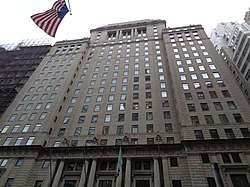| Cunard Building | |
|---|---|
 | |
 | |
| Alternative names | Standard & Poors Building |
| General information | |
| Status | Completed |
| Type | Office |
| Architectural style | Neo-Renaissance |
| Location | 25 Broadway Financial District, Manhattan, New York |
| Coordinates | 40°42′21″N 74°00′51″W / 40.70583°N 74.01417°W |
| Construction started | 1920 |
| Completed | 1921 |
| Opened | May 2, 1921 |
| Client | Cunard Line |
| Height | 254.74 feet (77.64 m) |
| Technical details | |
| Floor count | 22 (+1 basement) |
| Design and construction | |
| Architect(s) | Benjamin Wistar Morris III |
| Architecture firm | Carrère & Hastings |
| Designated | September 19, 1995 |
| Reference no. | 1928 (exterior) 1929 (interior)[1][2] |
| Designated | February 20, 2007[3] |
| Part of | Wall Street Historic District |
| Reference no. | 07000063[3] |
| References | |
| [4] | |
The Cunard Building, formerly the Standard & Poors Building, is a 22-story office building at 25 Broadway, across from Bowling Green Park, in the Financial District of Lower Manhattan in New York City. The Cunard Building was designed in the Italian Renaissance style by Benjamin Wistar Morris, in conjunction with consultants Carrère & Hastings. The Cunard Building's facade and principal first-floor interior spaces are New York City designated landmarks, and the building is also a contributing property to the Wall Street Historic District, a National Register of Historic Places district created in 2007.
The Cunard Building's main facade, on Broadway, is made of limestone and consists of three horizontal sections. The design employs setbacks and open "light courts" as mandated by the 1916 Zoning Resolution. The structure was designed around an irregular street grid and is located directly above a subway line that crosses the building site diagonally. The first floor interior contains an elaborately decorated lobby, as well as a similarly opulent Great Hall, which extends 185 feet (56 m) with a 65-foot-tall (20 m) dome. The remaining floors contain various offices and school spaces.
The Cunard Building was erected for the New York City office of British-American steamship operator Cunard Line; construction started in 1920 and the building was completed the next year. Upon completion, the Cunard Building's exterior and interior designs received critical acclaim, and the building was almost fully leased to tenants in various industries. The Twenty-five Broadway Corporation, a Cunard Line affiliate, owned the building until the 1960s. The Great Hall was vacated after the Cunard Line moved out in 1968; the United States Postal Service occupied the Great Hall from 1974 until 2000, and Cipriani S.A. started using the space in 2014. The upper floors continued to host offices and various educational facilities.
- ^ Cite error: The named reference
NYCL p. 1was invoked but never defined (see the help page). - ^ Cite error: The named reference
lpc95was invoked but never defined (see the help page). - ^ a b Cite error: The named reference
nris_2007was invoked but never defined (see the help page). - ^ Cite error: The named reference
emporiswas invoked but never defined (see the help page).